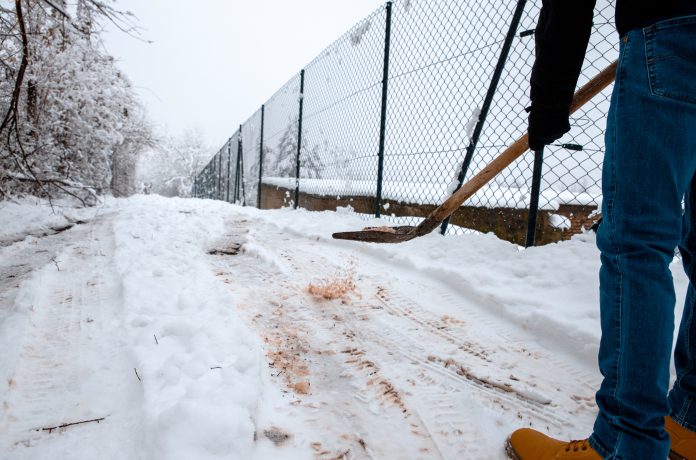Gareth Ellis, the Managing Director at EcoGrit Ltd, walks us through our legal responsibilities for de-icing during winter
Whether we are an individual, organisation, charity, business, or government body, we all have a legal responsibility if we rent, lease, own, or occupy a property and have staff, visitors, or deliveries over the winter.
In the UK, our weather patterns could be more consistent and over the past few years, weather patterns have changed. We cannot predict what areas of the country will get hit with bad weather (sub-zero temperatures). Sometimes, we can suffer lousy weather as a nation, but generally, it affects different areas at different times without much warning. This is why it’s imperative to be up to date with what our responsibilities are, what our actions result in, and what our options are. This is doubly important for logistics and the transport industry as their vehicles will be passing through multiple areas on their route.
Responsibilities for de-icing during winter
For the premises, most companies and organisations use an outside contractor for de-icing, which tends to use either standard rock salt or untreated salt. These contractors do the bulk of the area needed, but not all do 100% as they generally drive into sites with a vehicle, drive around in a particular pattern and then leave without getting out of their vehicles.
Very often, paths and walkways close to the buildings are missed, especially entranceways to buildings. Most places will have a caretaker or maintenance person who checks in cold weather, to make sure the areas are safe for staff and visitors to access the building.
This caretaker/maintenance person has an important role to play for a number of reasons:
- Even if the site has been gritted in the evening, if any areas had been missed or snow had been falling, then there would become dangerous icy patches, and as many people walk whilst looking at their phones, slips can happen. If the person slipping injures themselves, and they are a vital member of staff, this can become a costly and disruptive situation. The caretaker, on a walk around, could notice the patches and de-ice them (if in possession of EcoGrit.)
- If the temperature keeps dropping (ground temperature is approximately 2°C lower than air temperature) and the ground becomes colder than -6°C, then the ground freezes although it has been gritted. The maintenance person would be able to rectify this (if in possession of EcoGrit).
- If temperatures stay sub-zero throughout the day and there is light snow, then rock salt becomes saturated (it can’t absorb any more moisture, rendering it useless) and needs to be reapplied. In high-traffic areas, multiple applications can be needed, which becomes costly as it is labour-intensive and so much product is needed.
What is the actual cost of de-icing?
It isn’t easy to put an exact monetary figure on the cost of de-icing over winter because there are so many factors. Here are some to consider.
The initial cost of standard de-icing salts or rock salt is relatively low. They do the job in light frost with a single application, but this can soon multiply when the temperature drops or it starts to snow, as rock salt has a low moisture absorption threshold.
EcoGrit, on the other hand, has a higher initial price because of the processes it goes through. It has a really high moisture absorption threshold, meaning if there is a prolonged spell of freezing weather, EcoGrit doesn’t need to be reapplied so often, and a lot less of the product is required. This is because EcoGrit doesn’t refreeze.
This is due to the fact that EcoGrit can remove ice even at temperatures of -20°C and below. This then inadvertently reduces the labour time needed, reducing costs.
Unfortunately, rock salt and untreated de-icing salts are very corrosive. They damage the areas they are directly applied to, whether that’s tarmac, concrete, or metal. Rock salt can also be walked inside buildings on footwear, causing clean-up costs. If rock salt is walked onto carpets, it can slowly burn holes into the material. It eats away at tarmac (asphalt), and that is part of the reason why so many roads and car parks have potholes.
Potholes and defects are not only bad for cars but also present terrible trip hazards. The cost of fixing potholes and defects is not just the cost of fixing them but also the costs that arise from damage to vehicles, delays in deliveries, and injuries to people (putting in claims for damages).
What is the difference between rock salt and EcoGrit?
EcoGrit is 80% less corrosive than rock salt, and because less of the product is used for the same and better effect, the damage is minimal. EcoGrit is also granular rather than grit, meaning it breaks down and dissolves and is not walked indoors on people’s footwear. Therefore, less time and money are wasted on cleaning and repairs.
To us here at EcoGrit, the biggest downside (that isn’t talked about) with the use of rock salt on the scale it is used is the heavy metals and toxins it contains. Rock salt is mined directly from salt caverns under the ground (yes, we have lots of these) and is not cleaned or processed (that’s why it’s cheap). It poses a problem not just for the local environment but also for our health as the heavy metals and toxins end up in the water table.
When nature was locking these nasties away millions of years ago, people weren’t here growing food like we are today. Just because we have designed machinery to access this rock salt doesn’t mean we have to use it. As weather patterns worsen in the winter, the solution cannot be just to put more rock salt down.
EcoGrit prides itself on treating only different grades of clean marine salt mixed with a combination of other natural materials. Products from the brewery, animal feed, and cereals industries are also used in its creation.
EcoGrit has no handling restrictions. It can be stored indefinitely in dry conditions without deteriorating the quality of the product. It is safe to use around plants and animals.
EcoGrit Concentrate is the only product we produce, but it is available in various shapes and sizes. We have 1.2kg shakers, refill pouches, 5kg buckets and boxes. 20 kg buckets or bags. We sell items singularly or in bulk. We can supply in a covered mini bulk bag or by the tonne.
All of our products are shipped directly on an express service with tracking. For more information, please email questions@ ecogrit.co.uk or call +44 (0)800 193 6466.

This work is licensed under Creative Commons Attribution-NonCommercial-NoDerivatives 4.0 International.











